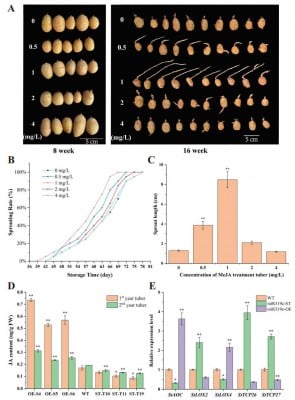Potato (Solanum tuberosum L.) is the world’s most important noncereal food crop, feeding billions globally. However, managing tuber dormancy and sprouting remains a longstanding challenge for both farmers and industry. Dormancy prevents sprouting immediately after harvest, protecting tubers during storage, yet premature or delayed sprouting disrupts supply chains, increases food waste, and reduces commercial quality. Environmental conditions such as temperature and humidity, alongside plant hormones like abscisic acid, gibberellins, and jasmonic acid, play critical roles in dormancy regulation. Although microRNAs are recognized as key genetic regulators in plants, their roles in tuber dormancy remain poorly understood. Due to these challenges, it is necessary to conduct in-depth research on miRNA-mediated dormancy release in potatoes.
Researchers from Gansu Agricultural University report a new study published (DOI: 10.1093/hr/uhae303) on October 30, 2024, in Horticulture Research. The team performed genome-wide profiling of small RNAs and degradome sequencing to investigate potato dormancy release. They identified stu-miR319c, a novel microRNA, as a central player in regulating the dormancy-to-sprouting transition. By suppressing the transcription factors StTCP26 and StTCP27 and activating jasmonic acid pathways, stu-miR319c effectively accelerated sprouting in transgenic potatoes. The discovery not only reveals new genetic mechanisms underlying dormancy but also provides promising avenues for molecular breeding.
The study analyzed over 275 million high-quality reads from small RNA sequencing across dormancy, dormancy release, and sprouting phases under both low (4°C) and normal (22°C) storage conditions. Researchers identified 396 microRNAs, including 192 novel sequences. Among these, stu-miR319c (novel_220) emerged as a key regulator, showing consistent differential expression during all stages of dormancy release. Functional assays demonstrated that stu-miR319c targets and cleaves StTCP26 and StTCP27, transcription factors known to regulate growth. Transgenic potatoes overexpressing stu-miR319c sprouted earlier than wild types, while silencing delayed sprouting, confirming its functional role. Exogenous treatment with 1 mg/L methyl jasmonate (MeJA) further accelerated sprouting by nearly nine days, supporting the hormone-linked mechanism. Gene expression analyses showed that stu-miR319c modulates key enzymes in the jasmonic acid pathway, including StAOC, StLOX2, and StLOX4. These findings establish stu-miR319c as an epigenetic switch coordinating hormone signaling and developmental timing in tubers.
“Potato dormancy is a double-edged sword—too short, and storage losses rise; too long, and planting is delayed,” said Dr. Ning Zhang, senior author of the study. “Our discovery of stu-miR319c as a regulatory hub provides a genetic tool to balance these competing needs. By modulating jasmonic acid pathways, we can now envision developing potato varieties with tailored dormancy periods. This research not only deepens our understanding of microRNA biology but also bridges molecular genetics with practical solutions for food security.”
The identification of stu-miR319c as a regulator of potato dormancy has significant agricultural implications. Breeding programs could harness this microRNA to engineer varieties with optimized dormancy durations—long enough to ensure safe storage and transport, yet short enough to guarantee timely sprouting for the next planting season. This balance is vital for reducing postharvest losses, stabilizing market supply, and supporting global food security. Furthermore, the findings may inspire research into similar epigenetic regulators in other crops with dormancy traits, expanding the toolbox for precision breeding and sustainable crop management in the face of climate and storage challenges.
###
References
DOI
Original Source URL
https://doi.org/10.1093/hr/uhae303
Funding information
This research was funded by the Gansu Science and Technology Major Project (No. 22ZD6NA009), National Key Research and Development Program of China (No. 2022YFD1602103), and the Gansu Science and Technology Major Project (No. 23ZDNA006).
About Horticulture Research
Horticulture Research is an open access journal of Nanjing Agricultural University and ranked number one in the Horticulture category of the Journal Citation Reports ™ from Clarivate, 2023. The journal is committed to publishing original research articles, reviews, perspectives, comments, correspondence articles and letters to the editor related to all major horticultural plants and disciplines, including biotechnology, breeding, cellular and molecular biology, evolution, genetics, inter-species interactions, physiology, and the origination and domestication of crops.

